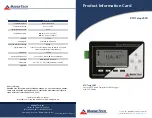
Section 7. Installation
190
Data Types in Final-Storage Memory
Name Argument
Description
Word
Size
(Bytes)
Notes
Resolution / Range
UINT4
UINT4
Unsigned
integer
4
Use to store positive count data ≤
2147483647.
Other uses include storage of long
ID numbers (such as are read from
a bar reader), serial numbers, or
address.
May also be required for use in
some Modbus devices.
0 to 4,294,967,295 (2
32
)
Boolean
Boolean
Signed integer
4
Use to store true or false states,
such as states of flags and control
ports. 0 is always false. –1 is
always true. Depending on the
application, any other number may
be interpreted as true or false. See
the section
True = -1, False = 0
(p.
To save memory, consider
using
UINT2
or
BOOL8
.
True =
–
1 or any number ≥ 1
False = any number ≥ 0 and < 1
Bool8
Bool8
Integer
1
8 bits (0 or 1) of information. Uses
less space than 32-bit BOOLEAN.
Holding the same information in
BOOLEAN will require 256 bits.
See
Bool8 Data Type
(p. 254).
True = 1, False
= 0
NSEC
NSEC
Time stamp
8
Divided up as four bytes of
seconds since 1990 and four bytes
of nanoseconds into the second.
Used to record and process time
data. See
NSEC Data Type
(p. 259).
1 nanosecond
String
String
ASCII string
Minimum
: 3 (4
with null
terminato
r)
Default:
24
Maximu
m:
limited
only to
the size of
available
CR6
memory.
See caution.
1
String size is defined by the CR6
operating system and CRBasic
program.
When converting from
STRING
to
FLOAT
, numerics at the
beginning of a string convert, but
conversion stops when a
non-numeric is encountered. If the
string begins with a non-numeric,
the
FLOAT
will be
NAN
. If the
string contains multiple numeric
values separated by non-numeric
characters, the
SplitStr()
instruction can be used to parse
out the numeric values. See the
sections
String Operations
(p. 379)
and
Serial I/O
(p. 356).
.
Unless declared otherwise, string size
is 24 bytes or characters. String size is
allocated in multiples of four bytes; for
example,
String * 25
,
String * 26
,
String * 27
, and
String * 28
allocate
28 bytes (27 usable). Minimum string
size is 4 (3 usable). See
CRBasic
Editor Help
for more information.
Maximum length is limited only by
available CR6 memory. As a special
case, a string can be declared as
String
* 1
. This allows the efficient storage of
a single character. The string will take
up 4 bytes in memory and when stored
in a data table, but it will hold only one
character.
Summary of Contents for CR6 Series
Page 2: ......
Page 4: ......
Page 6: ......
Page 32: ......
Page 36: ......
Page 38: ......
Page 76: ...Section 5 Overview 76 FIGURE 20 Half Bridge Wiring Example Wind Vane Potentiometer ...
Page 80: ...Section 5 Overview 80 FIGURE 23 Pulse Input Wiring Example Anemometer ...
Page 136: ......
Page 454: ...Section 8 Operation 454 FIGURE 104 Narrow Sweep High Noise ...
Page 459: ...Section 8 Operation 459 FIGURE 106 Vibrating Wire Sensor Calibration Report ...
Page 535: ...Section 8 Operation 535 8 11 2 Data Display FIGURE 121 CR1000KD Displaying Data ...
Page 537: ...Section 8 Operation 537 FIGURE 123 CR1000KD Real Time Custom ...
Page 538: ...Section 8 Operation 538 8 11 2 3 Final Storage Data FIGURE 124 CR1000KD Final Storage Data ...
Page 539: ...Section 8 Operation 539 8 11 3 Run Stop Program FIGURE 125 CR1000KD Run Stop Program ...
Page 541: ...Section 8 Operation 541 FIGURE 127 CR1000KD File Edit ...
Page 546: ......
Page 552: ......
Page 610: ...Section 11 Glossary 610 FIGURE 137 Relationships of Accuracy Precision and Resolution ...
Page 612: ......
Page 648: ......
Page 650: ......
Page 688: ......
Page 689: ......
















































